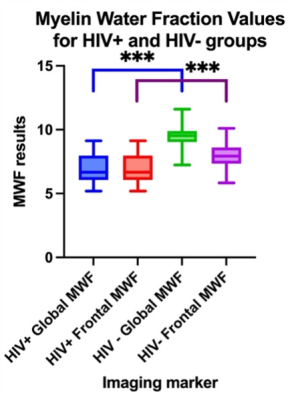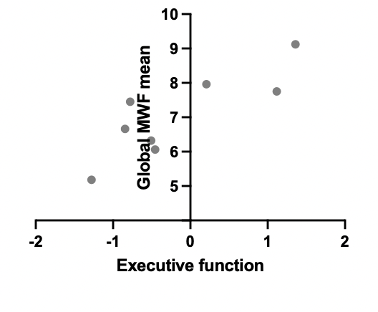3970
Decreased Myelin Content on Myelin Water Imaging and Correlation with Cognitive Performance in Adults with Perinatal HIV1University of Washington, Seattle, WA, United States, 2University of New Mexico, Albuquerque, NM, United States, 3Albert Einstein College of Medicine, Bronx, NY, United States, 4Yale University, New Haven, CT, United States, 5University of British Columbia, Vancouver, BC, Canada, 6University of British Columbia, Vancouver, BC, United States, 7Missouri Institute of Mental Health, St. Louis, MO, United States
Synopsis
Little is known about the pathology of cerebral white matter injury occurring in HIV. Myelin water imaging quantifies myelin content and results are expressed as myelin water fraction (MWF). We defined the cognitive profile of virally suppressed adults with perinatally acquired HIV (pHIV) and demonstrate the association between MWF and cognition. Ten (58%) adults with pHIV were cognitively impaired. Lower global MWF correlated with worse performance in executive function (r: 0.762, p: 0.037). Cognitive impairment is common among our cohort of adults with virally suppressed pHIV. Decreased myelination occurs in pHIV and may be a pathologic substrate of cognitive impairment.
Introduction
Neurodevelopmental impairment is common in children with perinatally acquired HIV (pHIV), occurring in approximately half of children and adolescents living with pHIV1,2. Little is known about the cognitive profile of adults with virally suppressed perinatally acquired HIV (pHIV). Additionally, the mechanism behind neurologic injury in pHIV is poorly understood. Conventional and diffusion tensor imaging have demonstrated diffuse structural white matter changes in children with pHIV3,4, but the microstructural pathology occurring in white matter tracts of individuals with pHIV remains unknown. Myelin water imaging (MWI), a novel imaging modality, quantifies myelin content using differences in relaxation times of water contained in the myelin bilayer and total water diffusion5. MWI has been pathologically validated in patients with multiple sclerosis (MS) who display decreased myelin water fraction, a metric of myelin content obtained using MWI6. Additionally, a decrease in myelin water fraction correlates with poor cognition in patients with MS to a greater extent than quantitative measures of white matter lesions found on conventional brain imaging sequences7. To date, this imaging modality has not been assessed in persons living with HIV. Here, we define the cognitive profile of virally suppressed adults with pHIV and demonstrate the association between myelin water fraction (MWF), a metric of myelin content obtained through MWI, and cognition in our cohort of adults living with well-controlled perinatally-acquired HIV.Methods:
Seventeen adults with pHIV (ages 21-36 years, 11 Female and 6 Male), virally suppressed on antiretroviral therapy (ART), underwent an 11-test cognitive battery covering seven domains. Raw scores were adjusted for age, education, sex, and race/ethnicity. Domain specific z-scores were determined using normative data. Cognitive impairment was defined as >1.5 standard deviations below the normative mean in 2 or more domains. Eight participants underwent MWI. A Gradient and Spin Echo acquisition sequence was used for MWI data processing. We calculated voxel-wise T2 distributions with a non-negative least squares fitting and flip angle optimization in MATLAB. Voxel-wise MWF was calculated by summing T2 amplitudes between 15-40 milliseconds and dividing by the sum of all T2 amplitudes (Figure 1). Global and frontal lobe MWF averages were developed and these data were compared to 16 historical age and sex matched controls. Correlations were assessed using Spearman rank correlation coefficient.Results
Participants with pHIV differed in years of education completed compared to our age and sex matched historical controls (12.6 years vs 17.5 years, p<0.001). Ten (58%) adults living with pHIV were cognitively impaired with the lowest scores in the gross motor (average z-score: -2.9) and verbal memory (average z-score: -1.5) domains (Figure 2). Global and frontal lobe MWF were lower in the pHIV cohort compared to matched uninfected controls (mean global and frontal MWF: pHIV: 0.071, 0.051; controls: 0.095, 0.081; p<0.0001) (Figure 3). Lower global MWF correlated with worse performance in the executive function domain in adults living with pHIV (Spearman r: 0.762, p: 0.037) (Figure 4).Discussion
Cognitive impairment is common among our cohort of adults with virally suppressed pHIV, particularly in the gross motor domain. This may be due to a legacy effect on motor development as individuals in this cohort were born during a period when access to ART was limited. Our pilot imaging data suggest that decreased axonal myelination may occur in individuals living with virally suppressed pHIV on ART. Given the strong correlation between MWF and executive function scores, this reduction in myelination may be a pathologic substrate of pHIV-related cognitive impairment.Conclusion
MWF may be a relevant biomarker for clinical prognostication and therapeutic trials in HIV-related cognitive impairment. Future studies will evaluate longitudinal changes in MWF in young persons living with HIV compared to demographically matched controls, particularly matching for education level as this variable is a known predictor of MWF.Acknowledgements
Research reported in this abstract was supported by the National Institutes of Health under award number K23MH119914.References
1. Govender R, Eley B, Walker K, et al. Neurologic and neurobehavioral sequelae in children with human immunodeficiency virus (HIV-1) infection. J Child Neurol 2011; 26(11): 1355-1364.
2. Phillips N, Amos T, Kuo C, et al. HIV-Associated Cognitive Impairment in Perinatally Infected Children: A Meta-analysis. Pediatrics 2016; 138(5).
3. Ackermann C, Andronikou S, Laughton B, et al. White matter signal abnormalities in children with suspected HIV-related neurologic disease on early combination antiretroviral therapy. Pediatr Infect Dis J. 2014;33(8):e207-212.
4. Hoare J, Fouche JP, Spottiswoode B, et al. A diffusion tensor imaging and neurocognitive study of HIV- positive children who are HAART-naive "slow progressors". J Neurovirol. 2012;18(3):205-212.
5. Laule C, Moore GRW. Myelin water imaging to detect demyelination and remyelination and its validation in pathology. Brain Pathol. 2018 Sep;28(5):750-764.
6. Laule C, Kozlowski P, Leung E, Li DKB, Mackay AL, Moore GRW. Myelin water imaging of multiple sclerosis at 7 T: correlations with histopathology. Neuroimage. 2008;40(4):1575-1580.
7. Abel S, Vavasour I, Lee LE, Johnson P, Ristow S, Ackermans N, Chan J, Cross H, Laule C, Dvorak A, Schabas A, Hernández-Torres E, Tam R, Kuan AJ, Morrow SA, Wilken J, Rauscher A, Bhan V, Sayao AL, Devonshire V, Li DKB, Carruthers R, Traboulsee A, Kolind SH. Associations Between Findings from Myelin Water Imaging and Cognitive Performance Among Individuals With Multiple Sclerosis. JAMA Netw Open. 2020 Sep 1;3(9):e2014220.
Figures



